Has Zoom Cornered the Video Conferencing Market?
Zoom has in the recent months rapidly engrained itself into our social consciousness, dominating people’s perspective of the video conferencing industry, while simultaneously integrating itself within everyday life through its applications in education, business, and modern social interactions. Having a single company seemingly visible in every aspect of life does begin to pose difficult questions. One such question might be if Zoom is a monopoly? However, it is important to gain perspective on this issue by first looking at the circumstances which lead to Zoom’s meteoric rise, and if they are still true today.
At the outset of the pandemic with the abrupt global lockdown, individuals at every level of society had a sudden and urgent need for a video conferencing platform. Having already penetrated into the business world, Zoom was well positioned to take on the needs of an ever-growing market. In doing so, Zoom exploited its large conferencing ability and easy to use nature by making many features free to use, instantly making the service a favorite among many.
Schools, particularly, were very receptive as they had to rapidly convert in person learning to an online setting while simultaneously catering to students from all over the world. These factors coalesced into making Zoom an industry leader for the, however, it must be considered if it still retains this leadership position today. First, the video conferencing sector is highly competitive as many companies provide a similar service, which gives the consumer the freedom of choice. Secondly, Zoom in the months following the lockdown found itself exposed to scandal for its privacy and security weaknesses. These vulnerabilities prompted government agencies to take action, such as New York City’s Department of Education prompting them to direct schools to “Move away from Zoom as soon as possible” (Danielle Filson, Department of Education spokesperson, CNN).
As a result, multiple video conferencing platforms have presented themselves as valid alternatives promoting competition within the industry. With all this information in mind one could argue that Zoom is not a monopoly as while it does retain a large user base other services remain an option that many businesses and schools opt for. These are Microsoft Teams, and Google Hangout among other platforms. Some of the companies which have moved away from Zoom include Back of America Corp. and Tesla Inc. (Fortune). Additionally, with having such a large user base Zoom has recently experienced issues in its ability to operate with such a high volume of users. Dickinson for one on August 24th experienced such connectivity issues as many classes had no other option but to cancel their meeting due to Zoom being down. While issues like this are nothing new, they do pose a larger than usual problem today due to the online nature of classes. However, a potential solution to any future Zoom outages is to have other video conferencing platforms available to both students and faculty.
Sources Cited:



